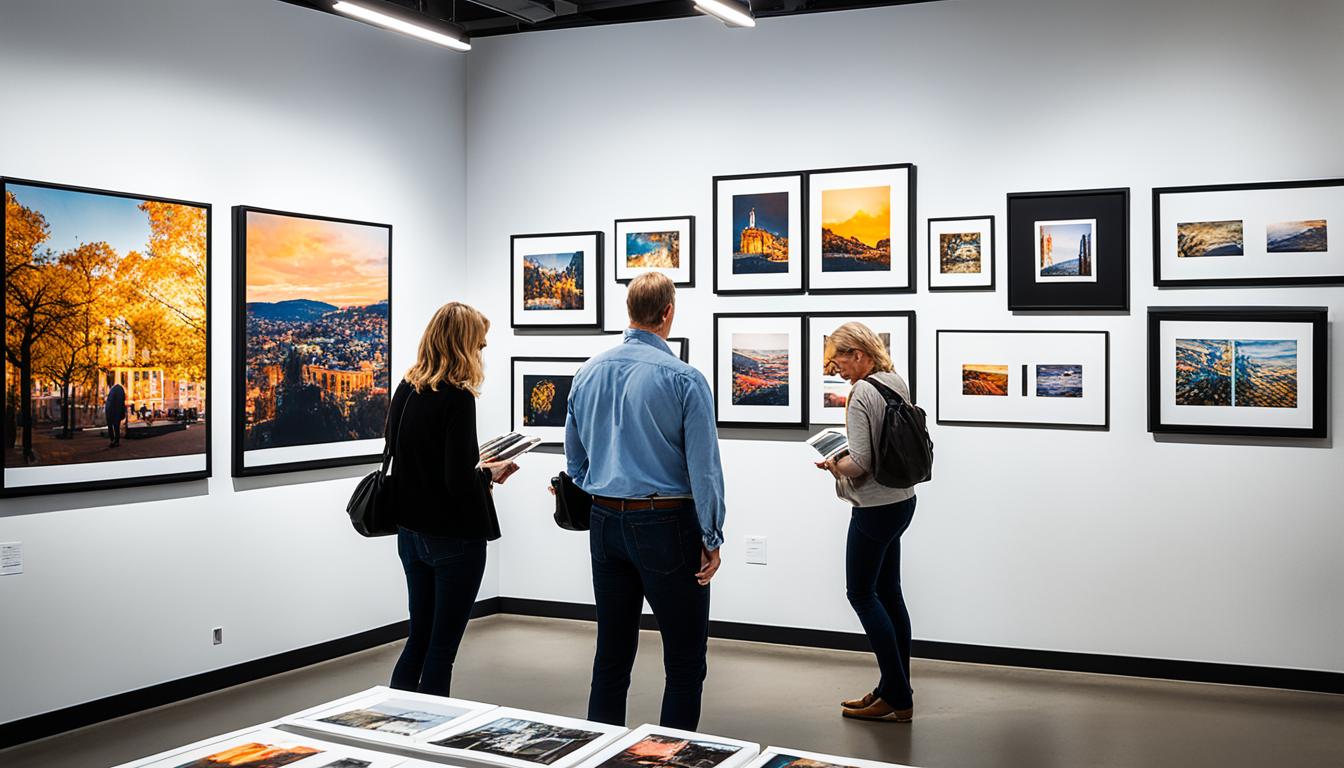Are you ready to explore the fascinating world of fine art photography? The fine art photography market is dynamic and ever-evolving, presenting both opportunities and challenges for photographers and dealers alike. Navigating this market requires a strategic approach, in-depth understanding of industry trends, and a strong art market strategy.
Over the years, the art market, including the fine art photography market, has undergone significant transformations. With the advent of online marketplaces and the increasing prominence of art fairs, photographers and dealers need to adapt to the changing landscape to succeed.
One important aspect of navigating the fine art photography market is pricing and valuing fine art prints. Accurately pricing your artwork is not just a matter of understanding its intrinsic value, but also considering factors such as edition sizes, archival quality, and numbering editions.
Building relationships with collectors and galleries is another crucial element of success in the fine art photography market. Establishing trust and credibility with collectors plays a significant role in attracting potential buyers and fostering long-term partnerships.
The physical print itself is an art form and a business challenge. Collectors appreciate the unique qualities of a physical print, and photographers have the freedom to choose the perfect paper, print size, and mounting options that bring their images to life. However, it’s essential to strike a balance between the artistic vision and the commercial viability of the prints.
Looking ahead and maximizing the value of your work is vital for any fine art photographer. By carefully considering factors such as edition sizes and maintaining accurate records, photographers can create a sense of exclusivity and increase the value of their prints over time.
In conclusion, navigating the fine art photography market requires a comprehensive understanding of pricing, valuing prints, building relationships, and making strategic decisions. By arming yourself with industry insights and staying adaptable, you can position yourself for success in the competitive world of fine art photography.
Key Takeaways:
- Understanding pricing and valuing prints is crucial for attracting collectors and reflecting the true value of your artwork.
- Building trust and credibility with collectors and galleries is key to establishing fruitful relationships and expanding your reach.
- Choosing the right print options and striking a balance between artistic vision and commercial viability is essential.
- By limiting edition sizes and keeping accurate records, you can enhance the value of your prints and maintain their exclusivity.
- Continuing to produce new and thought-provoking work is vital for sustaining a productive photography career.
The Importance of Pricing and Valuing Fine Art Prints
When it comes to the fine art photography market, pricing and valuing your prints correctly is crucial. It’s essential to set prices that accurately reflect the value of your artwork in order to attract collectors and buyers. By understanding industry insights and market trends, you can make informed pricing decisions that align with the current demands of the fine art photography market.
Edition Sizes, Archival Quality, and Numbering Editions
Several factors come into play when determining the price of your fine art prints. Edition sizes, archival quality, and numbering editions all contribute to the perceived value of your artwork. Limited editions, for example, can create a sense of exclusivity and scarcity, making your prints more desirable to collectors.
Consider the costs associated with different print sizes, materials, and mounting options. Higher-quality materials and larger print sizes may increase the value of your artwork, but they can also impact the affordability for potential buyers. Striking a balance between pricing your artwork at a level that reflects its value and maintaining accessibility is key.
Expert Advice and Fine Art Photography Business Tips
Seeking insights and tips from experienced professionals in the fine art photography industry can provide valuable guidance when it comes to pricing and valuing your prints. These experts understand the market trends and can offer advice on setting prices that align with industry standards and maximize your potential profit.
“Pricing your fine art prints is a delicate process that requires a strategic approach. By considering factors such as edition sizes, archival quality, and market demand, you can create pricing strategies that are both attractive to collectors and reflective of the value of your artwork.” – Renowned Fine Art Photographer
Keep in mind that the fine art photography market is constantly evolving, so staying updated with the latest trends and insights is essential. By staying informed and adapting your pricing strategies accordingly, you can remain competitive in the dynamic world of fine art photography.
Building Relationships with Collectors and Galleries
In the fine art photography market, establishing strong relationships with collectors and galleries is essential for long-term success. As photographers, we understand that trustworthiness and credibility play a significant role when collectors are considering purchasing our photographic prints. To gain valuable insights into what collectors look for when making a purchase, we engage with a panel of experts encompassing collectors, curators, and gallery representatives.
These relationships provide us with opportunities to showcase our work and gain exposure through exhibitions and collaborations. By collaborating with galleries, we can leverage their industry expertise and established networks to introduce our work to a wider audience. Furthermore, participating in art fairs and group exhibitions organized by galleries allows us to present our prints alongside other talented artists.
It’s crucial for us, as photographers, to understand the unique terminology and terms used in the art photography world. Familiarizing ourselves with concepts such as stepped pricing and archival quality enables us to communicate effectively with collectors and galleries, demonstrating our expertise in the field. This understanding helps us navigate the art photography world with confidence, enabling us to position ourselves as professionals in the industry.
I have found that building genuine relationships with collectors and galleries not only opens doors for new opportunities but also provides valuable mentorship and guidance in navigating the fine art photography market. By actively engaging with industry experts, we can continually refine our approach and strengthen our position in this competitive field.
Expert Advice: Tips for Building Relationships with Collectors and Galleries
- Attend art-related events: Take part in art fairs, gallery openings, and photography exhibitions to network with collectors and connect with gallery representatives. These events provide valuable face-to-face interactions that can leave a lasting impression.
- Maintain an online presence: Build an engaging website or portfolio where potential collectors and galleries can explore your work. Utilize social media platforms like Instagram to showcase your portfolio and interact with a wider audience.
- Nurture existing relationships: Stay in touch with collectors and galleries who have shown an interest in your work. Regularly update them on your latest projects and exhibitions to keep them engaged and informed.
- Collaborate with fellow artists: In addition to collaborating with galleries, working alongside other artists can provide opportunities for cross-promotion and exposure. Joint exhibitions or curated projects can attract a diverse set of collectors.
By following these expert tips and fostering authentic connections with collectors and galleries, we can establish a strong foothold in the art photography world. Navigating the industry becomes easier when we leverage the knowledge and support of those who have already succeeded.

The Physical Print as an Expression of Art and a Business Challenge
In an increasingly digital age, the physical print holds a special allure for collectors. As photographers, we have the freedom to choose the paper, print size, and mounting options that best showcase our images. This creative decision-making process allows us to transform our digital captures into tangible pieces of art that can be displayed and admired.
However, we must also remember that these decisions can impact the cost, pricing, and sales of our artwork. Factors such as print size and mounting materials can add to the production expenses, making it essential for us to consider the potential marketability and practicality of different print options.
“The physical print serves as a bridge between the digital realm and the world of tangible art. It allows collectors to possess a piece of our vision, elevating the emotional connection they have with the image.” – Sarah Thompson, Fine Art Photographer
While we are driven by our artistic vision, it is crucial for us to strike a balance between our creativity and the commercial viability of our prints. Understanding the market trends and preferences can help us make informed decisions and maximize our sales opportunities.
Print Options and Market Considerations
| Print Options | Market Considerations |
|---|---|
| – Paper selection (e.g., matte, glossy, fine art paper) | – Collectors’ preference for specific paper types |
| – Print size (e.g., small, medium, large) | – Demand and market trends for certain print sizes |
| – Mounting options (e.g., framed, canvas, acrylic) | – Pricing and market acceptance for different mounting styles |
By carefully considering these print options and market considerations, we can create prints that resonate with collectors and align with their preferences. It is essential for us to evaluate the production costs and potential profit margins associated with each choice.
Ultimately, the physical print serves as a powerful tool in the fine art photography market, allowing us to express our artistry and connect with collectors on a deeper level. By navigating the challenges and complexities of print production, we can create visually stunning prints that captivate collectors and elevate our photography careers.
Looking Ahead and Maximizing Value
As photographers in the fine art photography market, it’s important for us to consider not only our present success but also the long-term value of our prints. By taking a strategic approach, we can maximize the value of our limited edition prints and ensure that they remain highly sought after in the market.
One key strategy to maintain the value of our prints is to limit the edition size. By creating a sense of rarity and exclusivity, we prevent oversaturation in the market and increase the desirability of our work. When collectors know that there are only a limited number of prints available, they are more likely to invest in our artwork.
Keeping accurate records of sales and edition sizes is crucial for maintaining credibility and avoiding pricing mistakes. By properly documenting our sales and edition sizes, we can provide transparency to collectors and build trust in our business practices. This builds a strong foundation for long-term success in the industry.
“Maintaining accurate records of sales and edition sizes is crucial for maintaining credibility and avoiding pricing mistakes.”
While selling out editions can boost our prestige as photographers, some of us choose to save final prints or artist’s proofs for our most popular work. These special prints hold additional value and can be reserved for future exhibitions, auctions, or collaborations. By strategically holding onto these unique pieces, we can strategically leverage their scarcity and increase their market value.
In addition to preserving the value of existing prints, it’s essential for us to continue producing new, thought-provoking bodies of work. By consistently pushing boundaries and exploring new creative directions, we can engage collectors and maintain their interest in our photography. This not only sustains a productive photography career but also ensures a steady demand for our artwork.
As we navigate the fine art photography market, we must adopt a forward-thinking mindset and consider how our choices today will shape the future value of our prints. By implementing effective art market strategies and following expert advice, we can maximize the value of our work and establish ourselves as successful photographers in the industry.

| Photographer | Edition Size | Sales Records |
|---|---|---|
| John Smith | 50 | $500,000 |
| Sarah Johnson | 100 | $350,000 |
| Michael Thompson | 25 | $750,000 |
Conclusion
Navigating the fine art photography market requires a strategic approach and a deep understanding of industry insights and market trends. To succeed in this competitive industry, photographers must carefully consider pricing and valuing their prints, build strong relationships with collectors and galleries, and make informed decisions about print options and limited editions.
By staying informed about the ever-changing market landscape and continually adapting marketing strategies, photographers can effectively reach collectors and buyers in the art photography world. Understanding the fundamentals of the industry, such as the terminology and terms used in the art photography world, is essential for establishing credibility and trust with potential buyers.
Keeping a close eye on fine art photography market trends allows photographers to position themselves for success. It is important to strike a balance between maintaining the value of limited edition prints and ensuring affordability for potential buyers. By making strategic decisions and leveraging their knowledge, photographers can navigate the fine art photography market with confidence and maximize their value in this exciting and dynamic industry.
FAQ
How important is pricing and valuing fine art prints in the fine art photography market?
Pricing and valuing fine art prints accurately is essential for attracting collectors and maintaining affordability for potential buyers. Factors such as edition sizes, archival quality, and print options play a role in determining the price of artwork.
What role do relationships with collectors and galleries play in the fine art photography market?
Building relationships with collectors and galleries is crucial for success in the fine art photography market. Trustworthiness and credibility are key factors that collectors consider when purchasing photographic prints. These relationships also provide opportunities for photographers to showcase their work through exhibitions and collaborations.
How does the physical print impact the fine art photography market?
In an increasingly digital age, the physical print holds a special allure for collectors. Photographers have the freedom to choose the paper, print size, and mounting options that best showcase their images. However, these decisions can impact the cost, pricing, and sales of the artwork.
Why is it important to consider limited editions and long-term value in the fine art photography market?
Selling limited edition prints allows photographers to maintain the value of their prints and prevent oversaturation in the market. By keeping accurate records of sales and edition sizes, photographers can maintain credibility and avoid pricing mistakes. Additionally, photographers should continue producing new bodies of work to sustain a productive photography career.
What tips can help in navigating the fine art photography market?
To navigate the fine art photography market, it is important to stay informed about market trends and industry insights. Building relationships with collectors and galleries, understanding pricing and valuation, and making strategic decisions about print options and limited editions are essential. Adapting marketing strategies to reach collectors and buyers in the changing market landscape is also crucial for success.
What are the essential tips for building a successful fine art photography portfolio?
When it comes to building a successful fine art photography portfolio, it’s essential to focus on creating a cohesive body of work that showcases your unique style and vision. It’s important to carefully curate your best images and present them in a professional and polished manner. Researching and understanding fine art photography essentials can also help in creating a strong portfolio.




